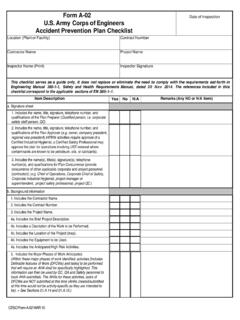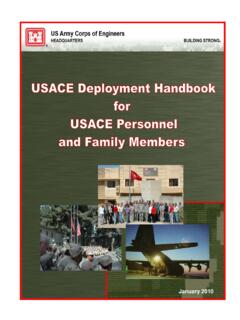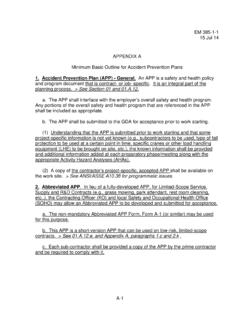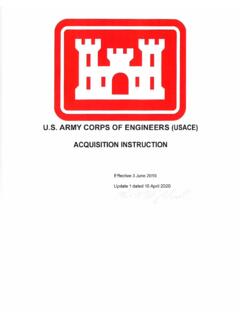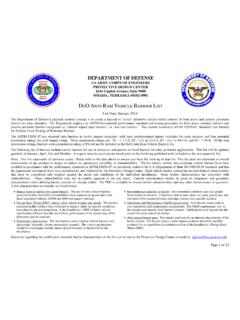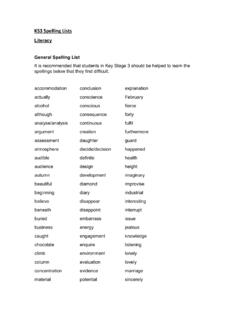Transcription of SECTION 21 - United States Army Corps of Engineers
1 EM 385-1-1 XX Jul 14 21-1 SECTION 21 Fall Protection General. The requirements of this SECTION are applicable to all Government and C work forces when their employees are working at heights, exposed to fall hazards and/or using fall protection equipment. Every Contractor and USACE-owned/operated permanent facility is responsible for establishing, implementing and managing a fall protection program. Fall Protection Threshold. a. The fall protection threshold height requirement is 6 ft ( m) for ALL work covered by this manual, unless specified differently below, whether performed by Government or Contractor work forces, to include steel erection activities, systems-engineered activities (prefabricated) metal buildings, residential (wood) construction and scaffolding work.
2 B. For all USACE-owned/operated permanent facilities with open-sided floors, platforms or unprotected edges 4 ft ( m) or more above adjacent floor or ground level, see SECTION Note 1: Floating Plant and Vessels are excluded from these requirements except where specifically cited in Sections and Note 2: For fall protection requirements for excavations, see SECTION Note 3: The Terms CP And QP in this SECTION refer to Competent Person for fall protection and Qualified Person for Fall Protection respectively. > See Sections , and Appendix Q.
3 Workers exposed to fall hazards shall be protected from falling to a lower level by the use of standard guardrails (see SECTION ), work platforms, temporary floors, safety nets, engineered fall protection systems, personal fall arrest systems, or the equivalent, in the following situations: a. Whenever workers are exposed to falls from unprotected sides or edges, access ways, fixed ladders over 20 ft (6 m) in height, unprotected roof edge or floor EM 385-1-1 XX Jul 14 21-2 openings, holes and skylights, unstable surfaces, leading edge work, scaffolds, formwork, work platforms, re-bar assembly, steel erection and engineered metal buildings; b.
4 For access ways or work platforms over water, machinery, or dangerous operations; c. When installing or removing sheet piles, h-piles, cofferdams, or other interlocking materials from which workers may fall 6 ft ( m) or more; Note: The use of sheet pile stirrups as a fall protection method is prohibited. d. Where there is a possibility of a fall from any height onto dangerous equipment, into a hazardous environment, or onto an impalement hazard; e. For steel erection activities, when connectors are working at the same connecting point, they shall connect one end of the structural member before going out to connect the other end.
5 The connectors shall always be 100% tied off. The order of control measures (the hierarchy of controls) to abate fall hazards or to select and use a fall protection method to protect workers performing work at heights shall be: a. Elimination: Remove the hazard from work areas or change task, process, controls or other means to eliminate the need to work at heights with its subsequent exposure to fall hazards ( , build roof trusses on ground level and then lift into place or design change by lowering a meter or valve at high locations to a worker s level).
6 This is the most effective control measure; b. Prevention (passive or same-level barrier): isolate and separate fall hazards from work areas by erecting same level barriers such as guardrails, walls, covers or parapets; c. Work platforms (movable or stationary): use scaffolds, scissor lifts, work stands or aerial lift equipment to facilitate access to work location and to protect workers from falling when performing work at high locations. > See SECTION ; d. Personal Protective Systems and Equipment: Use of fall protection systems, including (in order of preference): restraint, positioning, or personal fall arrest.
7 All EM 385-1-1 XX Jul 14 21-3 systems require the use of full body harness, connecting means and safe anchorage system. e. Administrative Controls: Introduce new work practices that reduce the risk of falling from heights, or to warn a person to avoid approaching a fall hazard ( , warning systems, warning lines, audible alarms, signs or training of workers to recognize specific fall hazards). When using stilts, or working from raised platforms or floors above a walking/working surface that exposes workers to a fall of 6 ft ( m) or more in areas protected by guardrails, the height of the guardrail must be raised accordingly to maintain a protective height of 42 in (107 cm) above the stilt, raised platform, floors or work stands.
8 DURING construction activities, fall protection is required for employees exposed to fall hazards while conducting inspection, investigation or assessment work. Prior to start of construction or after construction work is complete, fall protection is required when conducting inspection, investigation or assessment work within 6 ft ( m) from an unprotected edge of a roof. An AHA shall be developed and reviewed by a CP for this activity and submitted for GDA review and acceptance. Prior to start of construction or after construction work is complete, fall protection may not be required when conducting inspection, investigation or assessment work more than 6 ft ( m) away from an unprotected edge of a roof.
9 An AHA shall be developed and reviewed by a CP for this activity and submitted for GDA review and acceptance. During maintenance evolutions ( , inspecting or maintaining HVAC or other equipment on roofs), fall protection is required when conducting inspection and investigation work. Roles And Responsibilities. Fall Protection Program Manager (Program Administrator per ANSI ). The Program Manager is responsible for the overall development, implementation, monitoring and evaluation of the Fall Protection Program. This person can also function as a QP, CP, competent person trainer, qualified person trainer and/or competent rescue trainer if so trained.
10 The Program Manager shall: EM 385-1-1 XX Jul 14 21-4 a. be trained appropriately; b. advise and provide guidance for managers, employees and others on all matters pertaining to their Fall Protection Program; c. establish all duties and responsibilities required by the Fall Protection Program and assign them to individuals who are trained and qualified to perform them; d. verify that these personnel are provided with resources to accomplish their responsibilities; e. establish and implement a procedure to identify and eliminate or control new and existing fall hazards; f.
